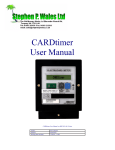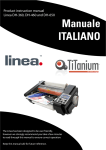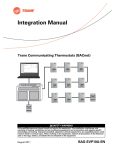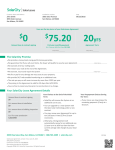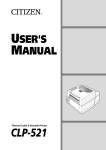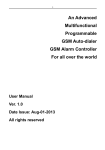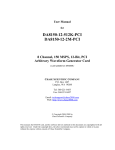Download CARDtimer User Manual
Transcript
CARDtimer User Manual (includes iSense) CARDtimer User Manual (inc iSense) ver 00g 2012-07-07.docx Author: Checker: Printing date and time: Steve Heaton Jason Paul 21/07/12, 07:11 CARDtimer User Manual (inc iSense) ver 00g 2012-07-07.docx Contents Page 1 REVISION RECORD .................................................................................................................. 4 2 INTRODUCTION......................................................................................................................... 5 2.1 2.2 2.3 2.4 2.5 GENERAL ......................................................................................................................................... 5 OPTIONS .......................................................................................................................................... 5 EXAMPLE APPLICATIONS:................................................................................................................ 6 KEY FEATURES ................................................................................................................................ 6 BUSINESS BENEFITS ......................................................................................................................... 6 3 DEFAULT REGISTER VALUES............................................................................................... 7 3.1 SETTINGS ......................................................................................................................................... 7 4 SPECIFICATION......................................................................................................................... 8 4.1 4.2 4.3 4.4 ELECTRICAL .................................................................................................................................... 8 PHYSICAL ........................................................................................................................................ 8 TIMING ............................................................................................................................................ 8 MISC ................................................................................................................................................ 8 5 INSTALLATION INSTRUCTIONS........................................................................................... 9 5.1 5.2 DIMENSIONS .................................................................................................................................... 9 DRILLING TEMPLATE ..................................................................................................................... 10 6 CONNECTION ........................................................................................................................... 11 6.1 6.2 CONNECTION – SINGLE LOAD ........................................................................................................ 11 CONNECTION – AUXILIARY LOAD (OPTION A) .............................................................................. 11 7 PROGRAMMING INSTRUCTIONS....................................................................................... 12 7.1 INTRODUCTION .............................................................................................................................. 12 8 FIXED REGISTERS .................................................................................................................. 16 8.1 8.2 8.3 8.4 8.5 INTRODUCTION .............................................................................................................................. 16 NUMCARDS................................................................................................................................ 16 TOTLSEC..................................................................................................................................... 16 REBOOTS .................................................................................................................................... 16 LOAD ........................................................................................................................................... 17 9 METHOD OF CHANGING VARIABLE REGISTERS......................................................... 18 9.1 9.2 9.3 INTRODUCTION .............................................................................................................................. 18 EXAMPLE OF CHANGING A REGISTER ............................................................................................ 18 COMPLETING PROGRAMMING ........................................................................................................ 20 10 LIST OF VARIABLE REGISTERS ......................................................................................... 21 10.1 10.2 10.3 10.4 10.5 10.6 11 11.1 11.2 11.3 12 12.1 13 TIMECRED ............................................................................................................................. 21 MAXCRED.............................................................................................................................. 21 TIMEWARN............................................................................................................................ 22 EQUIPTYP .............................................................................................................................. 22 SOUND.................................................................................................................................... 23 TICK ........................................................................................................................................ 24 ISENSE FUNCTION .................................................................................................................. 25 INTRODUCTION ......................................................................................................................... 25 ISENSE FUNCTION ..................................................................................................................... 25 ISINGLE FUNCTION ................................................................................................................... 25 USER INSTRUCTIONS ............................................................................................................ 27 INTRODUCTION ......................................................................................................................... 27 FREQUENTLY ASKED QUESTIONS .................................................................................... 28 PAGE 2 of 30 CARDtimer User Manual (inc iSense) 13.1 13.2 13.3 ver 00g 2012-07-07.docx DISPLAY.................................................................................................................................... 28 CARD ENTRY ............................................................................................................................ 29 ISENSE QUESTIONS ................................................................................................................... 30 PAGE 3 of 30 CARDtimer User Manual (inc iSense) 1 ver 00g 2012-07-07.docx REVISION RECORD Version no. 00a Revision Date 2011-05-15 Reason for Change First issue for firmware version ADXR100JADSC 00b 2011-06-07 00c 2011-06-13 00d 2012-03-09 00e 2012-04-19 First issue for firmware version ADXR100KADSC FAQ Section Added First issue for firmware version ADXR100KADSC ADXR100LADSC ADXR100MADSC ADXR100NADSC FAQ Section Added First issue for firmware version BCKR100RBCSC Added extra EQUIPTYP of BOOT HEATER, JET WASH, HOT TUB, MACHINE POWER, EQUIPMENT SUPPLY Covers software versions: ADXR100KADSC ADXR100LADSC ADXR100MADSC ADXR100NADSC BCKR100RBCSC BCKR100SBDSC 00f 2012-07-02 Expanded to include iSense versions 00g 2012-07-07 Explanation of iSense improved. Disclaimer of Liability The author shall not be held liable for any improper or incorrect use of the information contained herein and assumes no responsibility for anyone's use of the information. In no event shall the author be liable for any direct, indirect, incidental, special, exemplary, or consequential damages (including, but not limited to: procurement of substitute goods or services; loss of use, data, or profits; or business interruption) however caused and on any theory of liability, whether in contract, strict liability, tort (including negligence or otherwise), or any other theory arising in any way out of the use of this information, even if advised of the possibility of such damage. This disclaimer of liability applies to any damages or injury, whether based on alleged breach of contract, tortuous behaviour, negligence or any other cause of action, including but not limited to damages or injuries caused by any failure of performance, error, omission, interruption, deletion, defect, delay in operation or transmission, computer virus, communication line failure, and/or theft, destruction or unauthorised access to, alteration of, or use of any record. Indemnification User agrees to defend, indemnify, and hold harmless, the author from and against all claims and expenses, including solicitors' fees, arising out of the use of the information contained heirin. This equipment shall only be installed by suitably qualified and experienced persons. The timer is microprocessor controlled, and as with all systems, may fail or operate in an unexpected manner in the event of a fault. Always isolate mains supplies before installing, working on or modifying any wiring. Do not rely on the timer to isolate the load, always isolate upstream. PAGE 4 of 30 CARDtimer User Manual (inc iSense) 2 ver 00g 2012-07-07.docx INTRODUCTION 2.1 General 2.1.1 The CARDtimer is ideal for all situations where the duration of electricity usage needs to be controlled, and it is desirable to avoid coin timers with their inherent security, reliability and emptying issues. 2.1.2 The timer owner sells disposable cards to the customer, and sets the timer to provide an appropriate duration of electricity usage for the appliance. 2.1.3 For example, for a sun-bed, the owner may sell the cards to the customers at £3.25, and set the timer to provide 30 minutes of power to the sun-bed. 2.1.4 The cards can be sold in pounds, euros or any other currency. 2.2 Options 2.2.1 The standard cards are generally imprinted “ONE CREDIT”. Other text is available from your supplier. 2.2.2 Timers with Option A have a second controlled output which stays closed for 5 minutes after the main contact has opened. This may be used for fans or auxiliary lighting. 2.2.3 Timers with Option L have a backlit LCD display, ideal for installations in areas with low lighting levels, or for controlling lighting where the timer will not be easily visible until the lights are switched on by the timer itself. 2.2.4 Timers with Option S can be set to only count down when a certain load is exceeded. Please see the iSense chapter for more information. 2.2.5 Custom software applications can often be developed on request. PAGE 5 of 30 CARDtimer User Manual (inc iSense) 2.3 Example Applications: • • • • • • • • • • • 2.4 Gym equipment, Sun-beds, Tanning Booths Snooker Table Lights Vehicle cleaning – Vacuums, Jet-wash, etc Squash Court and Sports Field Lighting Washing Machine (operating the water inlet solenoid) Gaming Machines (control power to the display) Showers (including electric showers up to 25kW) Heating (control live supply to gas or oil heating system) Hairdryers & Hair Straighteners Air-conditioning Rented Workshops, Garages, & Premises Key Features • • • • • • • • • • • • • • • 2.5 ver 00g 2012-07-07.docx Uses secure disposable magnetic cards When card is inserted, time credit is copied from the card to the timer Multiple cards may be entered in one session Card is erased and permanently marked CARDtimer display counts down in hours, minutes and seconds User settable duration of 0 to 999,999seconds (0 to 227hrs) per card Maximum accumulated time is unlimited User friendly 16 character LCD display Master Programming Card allows settings to be easily changed Switches up to 100A and can supply up to 25kW of load Red led clearly indicates the supply contactor is closed Optional warning beeper when credit running out No battery replacement required – design lifetime 20 years Independent of currency Landlord Mode (dispenses electricity without charge) for friends and family use Business Benefits 2.5.1 Incidental sales resulting during the purchase of cards 2.5.2 Sales are not lost due to consumers not having the correct change 2.5.3 Ability to flexibly change the time and cost per session 2.5.4 No attraction for theft either from the meter, or by staff pilfering 2.5.5 Meter keeps a record of number of cards inserted, and total time vended 2.5.6 Better control of cash (no need to periodically empty meters of coins) PAGE 6 of 30 CARDtimer User Manual (inc iSense) 3 ver 00g 2012-07-07.docx DEFAULT REGISTER VALUES 3.1 Settings 3.1.1 The CARDtimer has various registers which can be adjusted by the user, depending on the application. 3.1.2 The default values are shown here, together with any adjustments made by your supplier or electrician. Value Factory Adjusted Setting Value EQUIPTYP 108 [BLANK] text to be displayed alternately with INSERT CARD, when the credit has reached zero TIMECRED 30sec number of seconds credited for each card inserted MAXCRED 60sec number of seconds of credit which can be added by the user TIMEWARN 15sec start of warning sound that credit is running out iThresh 100 Level of load below which the timer will stop counting down (only used when iSense option is provided) SOUND ON sound confirmations when keys are pressed, cards are inserted, or the display shows a message TICK ON tick sound each time a second elapses PAGE 7 of 30 CARDtimer User Manual (inc iSense) 4 4.1 4.2 ver 00g 2012-07-07.docx SPECIFICATION Electrical Voltage Rating 220-250Vac 50Hz Current rating 100A main contactor 5A auxiliary contactor (option A timers only) Maximum cable diameter 8mm (main terminals) 3.2mm (auxiliary terminals) Physical Height Width Depth Weight 4.3 Timing Duration per card (user settable) Maximum time credit (user settable) Timing accuracy 4.4 171mm 124mm 92mm 950g 1 to 999,999 sec (0 to 277hrs) unlimited 1% Misc Design lifetime IP rating 20yrs IP20 PAGE 8 of 30 CARDtimer User Manual (inc iSense) 5 ver 00g 2012-07-07.docx INSTALLATION INSTRUCTIONS 5.1 5.1.1 Dimensions Allow 50mm clear below the timer for wiring connections. PAGE 9 of 30 CARDtimer User Manual (inc iSense) 5.2 ver 00g 2012-07-07.docx Drilling Template PAGE 10 of 30 CARDtimer User Manual (inc iSense) 6 ver 00g 2012-07-07.docx CONNECTION 6.1 6.1.1 6.2 Connection – Single Load The CARDtimer is able to support a load of up to 100A from the main terminals. Connection – Auxiliary Load (Option A) 6.2.1 The CARDtimer is capable of switching an auxiliary load of up to 5A (timer with option A only). 6.2.2 The relay contact within the timer opens 5 minutes after the main contact opens, and is ideal to operate background lamps, fans and so on after the main contact has opened. PAGE 11 of 30 CARDtimer User Manual (inc iSense) 7 ver 00g 2012-07-07.docx PROGRAMMING INSTRUCTIONS 7.1 Introduction 7.1.1 The CARDtimer can only be programmed using the master programming card originally supplied with the timer (replacements are available from your supplier). 7.1.2 The master programming card is inserted in the card slot on the front of the CARDtimer, magnetic strip upwards. This can be done whenever “INSERT CARD” is displayed, or when the timer is running (timer continues to count down in the background during programming). 7.1.3 The card needs to be inserted in one smooth action. If the card is inserted too fast, or too slowly, then the timer will display “CARD ERROR”. 7.1.4 If this happens, wait for the timer to display “INSERT CARD” and then try again. 7.1.5 When you have successfully inserted the master programming card, the display will show “*PROGRAMMING*”, and will cycle through the registers as shown below. The actual values may vary slightly depending on the software version. PAGE 12 of 30 ver 00g 2012-07-07.docx FIXED REGISTERS CARDtimer User Manual (inc iSense) PAGE 13 of 30 CARDtimer User Manual (inc iSense) ver 00g 2012-07-07.docx From previous page GREY> MOVE RIGHT BLUE> SWAP VALUE WAIT> WHEN DONE 0 TIMECRED 000030s Number of seconds credited by each card inserted. Can be adjusted at this point. Initial value 30s. Range 0 to 999,999sec per card. MAXCRED 00000060s Maximum number of seconds of credit which the user can add. Initial value 60s. Maximum value 9,999,999 seconds. TIMEWARN 0 00s EQUIPTYPE 0 010 Point at which audible warning of that time is about to expire. Can be adjusted. Range 0-199sec. Continued on next page PAGE 14 of 30 CARDtimer User Manual (inc iSense) ver 00g 2012-07-07.docx ADJUSTABLE REGISTERS Jumps past if iSense=OFF PAGE 15 of 30 CARDtimer User Manual (inc iSense) 8 ver 00g 2012-07-07.docx FIXED REGISTERS 8.1 8.1.1 8.2 Introduction Once in programming mode, the CARDtimer will provide information from its internal registers. These registers contain records of various values, some of which are set to zero at the time of timer manufacture. It is not possible to subsequently reset or change these registers, so they provide a true record of the usage of the timer. NUMCARDS 8.2.1 This register records the number of cards successfully used by consumers since the manufacture of the timer and this value will increase by one each time a card is inserted. 8.2.2 This register is set to zero at the time of manufacture and cannot be reset. Note, this value may be modified by factory tests before dispatch. 8.2.3 The display below shows that 155 cards have successfully been used: 8.3 TOTLSEC 8.3.1 This register records the number of seconds purchased by consumers since the manufacture of the timer. This value will increase by the amount of time purchased by each card when it is inserted. 8.3.2 This register is set to zero at the time of manufacture and cannot be reset. Note, this value may be modified by factory tests before dispatch. 8.3.3 The display below shows that the total time vended so far has been 7200 seconds: TOTLSEC 8.4 7200 REBOOTS 8.4.1 This register records the number of reboots of the microprocessor since the manufacture of the timer. A reboot occurs each time the mains fails. If there are an excessive number of reboots it may indicate that there have been attempts at tampering with the timer. 8.4.2 This register is set to zero at the time of manufacture and cannot be reset. Note, this value may be modified by factory tests before dispatch. 8.4.3 The display below shows that the microprocessor has rebooted three timese since the CARDtimer was manufactured: 8.4.4 This number should be noted down after installation, and any significant increase investigated. PAGE 16 of 30 CARDtimer User Manual (inc iSense) 8.5 ver 00g 2012-07-07.docx LOAD 8.5.1 If a version of the timer is used which has the iSense option, the timer is able to measure the load. When the load is below a threshold set, the timer can be set to stop counting down (see the iSense chapter later). 8.5.2 The load value is approximately 100 with a 100W load, with a minimum displayed value of 80. The displayed value is not a reliable measure of the load, but only an indication for the purpose of setting the threshold. 8.5.3 For full details, see the iSense chapter later. 8.5.4 The display below shows that the CARDtimer is measuring a load of approximately 80W (note this is the minimum reading, so the load could be anywhere between 0W and 80W): PAGE 17 of 30 CARDtimer User Manual (inc iSense) 9 ver 00g 2012-07-07.docx METHOD OF CHANGING VARIABLE REGISTERS 9.1 Introduction 9.1.1 The variables in this section are settable by the user. You will need to have entered the programming mode using the master programming card, see the previous section. 9.1.2 Registers which may be adjusted are displayed with a black flashing cursor, at the digit or value position which can be changed. 9.1.3 If a key is not pressed, the CARDtimer will move on to the next settable value after 5 seconds. 9.1.4 If you change a value, wait for 5 seconds after your last key press. The timer will accept you value and move to the next settable value. 9.1.5 If you make a mistake, just let the timer step through all the settable values, and then start again, by inserting the master programming card again. 9.2 Example of Changing a Register 9.2.1 The TIMECRED register shows the number of seconds that will purchased by consumers for each insertion of a card. For example, if you want to provide 25 minutes for each insertion of a card (1500 seconds), then set this value to TIMECRED 1500s. 9.2.2 The display will show the present value, with a flashing cursor. 9.2.3 Use the grey button to move the cursor under the digit you wish to change. PAGE 18 of 30 CARDtimer User Manual (inc iSense) ver 00g 2012-07-07.docx 9.2.4 Press the blue button to change the digit value. 9.2.5 Press the grey button to move on to the next digit. 9.2.6 To change the digit to a 5, press the blue button repeatedly until 9 shows, and then continue pressing and the value step through 0, and count up to 5. 9.2.7 The value is now changed to 1500s, wait 5 seconds and the timer will move on to the next settable value. 9.2.8 If you have made a mistake, then wait until the PROGRAMMING DONE message has displayed, and then start again inserting the master programming card. PAGE 19 of 30 CARDtimer User Manual (inc iSense) 9.3 9.3.1 ver 00g 2012-07-07.docx Completing Programming Finally, after the opportunity to change any of the variables, the timer will display PROGRAMMING DONE and then revert to the timer function. PAGE 20 of 30 CARDtimer User Manual (inc iSense) ver 00g 2012-07-07.docx 10 LIST OF VARIABLE REGISTERS 10.1 TIMECRED 10.1.1 This register sets the number of seconds credited for each card inserted. 10.1.2 The value can be changed as explained in the previous section. 10.1.3 TIMECRED can be set between zero and 999,999seconds. 10.1.4 If TIMECRED is set to less than MAXCRED, then MAXCRED will be updated automatically to match TIMECRED. If MAXCRED were not adjusted in this way, it would not be possible to add any credit to the timer, as any credit added by the insertion of a card would result in an amount of credit above MAXCRED, and so would not be accepted. 10.1.5 If TIMECRED is set to zero, the CARDtimer erases any remaining time, and enters LANDLORD MODE. In this mode the meter dispenses electricity without the user needing to enter cards. This mode is ideal for testing purposes, or friends and family. 10.1.6 To return to normal operation, program the TIMECRED register to a value other than zero. 10.2 MAXCRED 10.2.1 This register sets the number of seconds of credit which can be added by the user. 10.2.2 For instance, if MAXCRED is set to 1200 (seconds) and TIMECRED is set to 600 (seconds), then a maximum of two cards can be inserted at a time. Another card can only be inserted after the displayed credit falls below 600 seconds. MAXCRED 1200s 10.2.3 MAXCRED can be set between zero and 9,999,999seconds. 10.2.4 If accepting credit from a card will cause the credit to exceed MAXCRED, the display shows CREDIT FULL. 10.2.5 If TIMECRED is set to less than MAXCRED, then MAXCRED will updated automatically to match TIMECRED. If MAXCRED were not adjusted in this way, it would not be possible to add any credit to the timer, as any credit added by the insertion of a card would result in an amount of credit above MAXCRED, and so would not be accepted. PAGE 21 of 30 CARDtimer User Manual (inc iSense) ver 00g 2012-07-07.docx 10.3 TIMEWARN 10.3.1 This register shows when consumers will be warned that their credit is running out. For example, if the TIMEWARN is set to 60s then a warning sound will be produced by the timer one minute before the credit runs out. This gives consumers a chance to purchase additional credit. 10.3.2 This register is set to 60sec at the time of manufacture. It can be changed by the user within the range is 0-199 seconds. 10.3.3 If TIMECRED is set to a value below TIMEWARN, the TIMEWARN is automatically adjusted to match. 10.4 EQUIPTYP 10.4.1 This register records the text to be displayed alternately with INSERT CARD, when the credit has reached zero. 10.4.2 This register can be altered by the user. EQUIPTYPE 10.4.3 010 For possible values, please see the next section. PAGE 22 of 30 CARDtimer User Manual (inc iSense) 10.4.4 ver 00g 2012-07-07.docx The acceptable values are as follows: 0 No equipment type (ie blank) 1 SUNBED 2 TANNING BOOTH 3 SNOOKER TABLE 4 LIGHTS 5 HEATING 6 HEATER 7 VAC 8 VACUUM 9 POOL LIGHTS 10 COURT LIGHTS 11 SQUASH COURT 12 GAMES MACHINE 13 PITCH LIGHTS 14 WASHING MACHINE 15 TUMBLE DRIER 16 SHOWER 17 HEATING SYSTEM 18 HAIR DRIER 19 HAIR STRAIGHTNERS 20 AIRCON 21 AIRCONDITIONING 22 SHOWER 1 23 SHOWER 2 24 POWER PLATE 25 JETWASH 26 HOT TUB 27 MACHINE POWER 28 EQUIPMENT SUPPLY 100 CARDtimer 101 CARDmeter 113 iSense CARDtimer other values 29-199 No equipment type (ie blank) 10.5 SOUND 10.5.1 This register records whether the timer will sound confirmations when keys are pressed, cards are inserted, or the display shows a message. 10.5.2 Setting SOUND to OFF automatically sets TICK to OFF. 10.5.3 This register is set to ON at the time of manufacture. It can be changed to OFF by the user (see following section). PAGE 23 of 30 CARDtimer User Manual (inc iSense) ver 00g 2012-07-07.docx 10.6 TICK 10.6.1 This register records whether the timer will produce a tick sound each time a second elapses. This can be useful to alert users that the timer has started, and their credit has begun to be used up. 10.6.2 Setting SOUND to off automatically sets TICK to OFF. 10.6.3 This register is set to ON at the time of manufacture. It can be changed to OFF by the user (see following section). PAGE 24 of 30 CARDtimer User Manual (inc iSense) ver 00g 2012-07-07.docx 11 ISENSE FUNCTION 11.1 Introduction 11.1.1 The iSense function is available as an option (CARDtimer with Option S). 11.1.2 If the CARDtimer has this option, the iSense settings will appear in the list of registers when programming the CARDtimer. 11.1.3 The additional menu items are: iSense iThresh iSingle ON/OFF 100 ON/OFF These are discussed in detail in the sections below. 11.2 iSense Function 11.2.1 If enabled (iSense set to On in the programming menu) then the CARDtimer continuously monitors the consumption of the load. When the load falls below the setting of iThresh for a period of time, the timer stops counting down and *PAUSED* is shown on the left of the display. 11.2.2 The time between the load being removed and the timer pausing is between one and five seconds. 11.2.3 The default setting for iThresh is 100, with this setting the timer will run when a 60W bulb is connected, and stop when it is removed. The figure is adjustable from 0 to 199, although the minimum recognised load is approximately 40W. 11.2.4 In order to see the measured load value with the equipment stopped, insert a value card so that the timer is running, and then insert the programming card. In the programming menu, the LOAD value will be displayed. LOAD 11.2.5 80 It is recommended to set the iThresh value to approximately 20 counts above this (ie 100 in this case). 11.3 iSingle Function 11.3.1 For some equipment, it is desirable to have the timer only start counting down when the load is switched on. After that point, the timer is required to run until the credit has been used up. Typical applications are electric showers and sun beds. PAGE 25 of 30 CARDtimer User Manual (inc iSense) 11.3.2 ver 00g 2012-07-07.docx The iSingle function allows this. When selected to ON, the timer starts in paused mode, and stays paused until the load is switched on. Once the load has been switched on for 20 seconds the pause function is inhibited, and the timer will continue to run until all the credit is used up. Turning off the load after the 20 second window has passed will no longer pause the timer. 11.3.3 When set to OFF, the timer can be paused a number of times, for instance when used with an air-conditioner the timer can be set to several hours per card, and the timer only counts down when the air-conditioner is running. PAGE 26 of 30 CARDtimer User Manual (inc iSense) ver 00g 2012-07-07.docx 12 USER INSTRUCTIONS 12.1 Introduction 12.1.1 The CARDtimer provides electricity for a set amount of time whenever a card is inserted. 12.1.2 A card can be inserted whenever “INSERT CARD” is displayed, or when the timer is counting down. 12.1.3 Each card needs to be inserted in one smooth action. If the card is inserted too fast, or too slowly, then the timer will display “CARD ERROR”. 12.1.4 If this happens, wait for the timer to display “INSERT CARD” and then try again. 12.1.5 If you insert a card which has previously been used, the card will be ignored. 12.1.6 When you have successfully inserted the card, credit will be added to the timer, and the countdown will begin. The red light on the front of the timer will light. 12.1.7 When the time is nearly elapsed, the timer may make a warning sound, and then the electricity will be cut off. The red light on the front of the timer will go out. 12.1.8 You can insert another card at any time to extend the amount of time purchased. 12.1.9 If you have card problems, the meter owner can interrogate internal registers of the meter to determine what cards have been inserted and if any issues have been encountered in processing your cards. PAGE 27 of 30 CARDtimer User Manual (inc iSense) ver 00g 2012-07-07.docx 13 FREQUENTLY ASKED QUESTIONS 13.1 Display Q. The display shows CARD ERROR. What does this mean? A. The fact that CARD ERROR is shown, means that there is data on the card, but it is not recognised as valid. The data on the card may be corrupt, or the card may have been inserted too fast or too slow. Each time a card is inserted, the magnetic data is read off the card. If the data read does not match that which the timer is expecting for a valid card, the display will show CARD ERROR. The most common reason is that the card has been inserted too quickly or too slowly (the card will not be erased in this instance). Always ensure that the card is inserted with one smooth action. If the problem is with the meterman card, check that the value cards can be read successfully – this will show if there is a problem with the speed that the cards are inserted. The card may have already been used (look for an indentation in the card showing it has already been “clipped”). The card may not have been supplied by your original supplier. Only cards from the original supplier of the CARDtimer will add credit to the CARDtimer. The card may have been erased by having been stored in a magnetic field (ie on a loudspeaker, on top of the television, or next to credit cards). If this happens, you can expect your customer to be in contact. It is recommended to check the total number of cards the customer has bought from you, the total inserted and the number of cards the customer has not used yet. Q. The display shows CREDIT FULL. What does this mean? A. Each time a card inserted, the magnetic data is read off the card. If the data read matches that which the timer is expecting for a valid card, and there is zero credit on the timer, then the credit will be erased from the card and transferred to the timer. If there is already some remaining credit on the CARDtimer, and another card is inserted, the timer will check if the timer owner has set a maximum amount of credit which the timer is allowed to accumulate. This is set with the register named MAXCRED. For instance, if TIMECRED is set to 60 seconds (so that each card gives 60 seconds of credit), and MAXCRED is set to 180 seconds, then up to three cards can be inserted. Additional cards will not be accepted until the amount of remaining credit falls to 120sec or less. If cards are inserted, that if accepted by the timer, would result in a credit in the timer of greater than MAXCRED, then they are not erased and the display shows CREDIT FULL. PAGE 28 of 30 CARDtimer User Manual (inc iSense) ver 00g 2012-07-07.docx Q. The display shows MAINS FAILED. What does this mean? A. If the mains supply fails, such that the microcontroller within the timer stops functioning, then when the supply is restored, the microcontroller performs a self-test. During this initialisation, the settings in place prior to the mains failure are reinstated and the display shows MAINS FAILED during this process. Q. The display shows LANDLORD MODE. What does this mean? A. If TIMECRED is set to zero, the CARDtimer erases any remaining time, and enters LANDLORD MODE. In this mode the meter dispenses electricity without the user needing to enter cards. This mode is ideal for testing purposes, or friends and family. To leave landlord mode, and restore normal operation, set TIMECRED to a value other than zero. 13.2 Card Entry Q. What should I see when inserting a value card? When inserting a value card, the meter will display *THANK YOU* . This will remain on the display for two seconds. On removal, the card will be erased and marked (“clipped”). Q. The timer ignores the fact I have inserted a card. A. Each time a card is inserted, the magnetic data is read off the card. If the card is blank or corrupted, or the card has been inserted too fast or too slow, the card will not be recognised. Check to see if the card has previously been used (look for three small indentations). It is important to insert the card in one smooth action. Q. The card is difficult to pull out. A. When the credit from a valid card is accepted by the meter, and the card is removed, it is marked with three small indentations. The process of producing these indentations results in slight resistance when the card is being withdrawn. Q. I have lost the meterman card? A. Additional meterman cards are available from your supplier for a nominal charge. Q. I need some more cards, what do I do? A. Additional timer cards are available from your supplier. You will need to identify yourself for security reasons and describe the printed text on the card clearly to make sure that the correctly coded cards are supplied for your meter. PAGE 29 of 30 CARDtimer User Manual (inc iSense) ver 00g 2012-07-07.docx 13.3 iSense Questions Q. How do I know if the CARDtimer I have has iSense?? A. Check in the programming menu to see if the iSense ON/OFF setting is available. Q. What should I set iLoad to? A. The default setting is 100. With this setting, a 60W light-bulb load will cause the CARDtimer to run. The load can be checked in the programming menu (insert a value card first to make sure that the contactor is closed and power is therefore available to the load). The menu item LOAD shows the current load. It is recommended to set iLoad to this value plus 20, ie if the indicated load is 80, set iLoad to 100. Q. The CARDtimer is not pausing when the load is disconnected? A. If you are using a CARDtimer with the iSense function switched ON in the programming menu, the timer will run whenever the load is above the iThresh setting. When the load is below the IThresh setting the timer will pause after a few seconds, and show *PAUSED* in the display (it will only pause if iSingle is set to OFF). Check the settings in the programming menu. Check that iSingle is set to OFF, otherwise the timer can only start in paused mode, and cannot enter paused mode once it has been running for 10 seconds. Also, check the LOAD entry in the menu and the iLoad setting (see above). With iThresh setting of 100, the timer will run with a 60W bulb connected and will stop when it is removed. Q. What options does the meter have? A. The following factory options are available: Option A: Auxiliary relay output Option L: Backlit display Option S: iSense PAGE 30 of 30






























